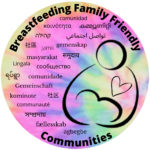STEPS 7 & 10: Businesses…in the community welcome chest/breastfeeding families…Education systems, including childcare, K-12, colleges and universities, are encouraged to include chest/breastfeeding friendly curricula at all levels.
Ten Steps to a Breastfeeding Family Friendly Community
Educators have the amazing opportunity to begin the process of normalizing breastfeeding, chestfeeding, and human milk feeding for children.
Many of us remember learning about “mammals” in our science classes – from elementary school to high school; yet, how many of us were taught that, because we are mammals, it is normal for us to feed our children from the breast/chest or to feed human milk? As teachers, we normalize breastfeeding/chestfeeding/human milk feeding, when we discuss with our students how we feed our children and when we provide books and activities that include images of chest/breastfeeding parents and children.
We also normalize chest/breastfeeding in our schools through policies that allow parents to chest/breastfeed in the classroom, when volunteering or attending functions, and throughout the facility wherever the parent is allowed to be. Students also should be exposed to breastfeeding as part of all health and family education.
Getting started in your community
Building a Breastfeeding Friendly Curricula
- Research resources for students. Some ideas are included here.
- Create a list of books for students of all ages and in all grades that include breastfeeding images.
- Review the BFFC Curricula for very young children
- Check out the information for high school students: A Breastfeeding Information and Activity Kit for Secondary School Teachers from Ontario Public Health Association, Canada.
- This document is from 2009, and the way we think about gender has evolved. Reflect the needs of your community.
- Some of the links in the document may be out of date.
- Explore the information in Prenatal Education in Ontario (CA): Better Practices, including the section on Program Planning for Adolescent Parents.
- Find out who makes curriculum changes in your school district.
- Contact the local school board or department of education.
- In the US, you may need to contact your State Board of Education.
Supporting breastfeeding students and employees
- Find advocates.
- Learn who is the school’s best decision making power.
- Reach out to teachers who may be challenged right now with balancing their desire to continue to breastfeed/express milk during the day and keeping up with the class schedule.
- Listen to their stories.
- Contact the Human Resources (HR) department in your community’s school district.
- A Breastfeeding Family Friendly Communities team met with the HR department in their local school district, provided information on the importance of supporting breastfeeding in the schools, and was able to furnish lactation rooms in 14 schools for $1200.
- Get the message out.
- Speak at a Chamber of Commerce “open mic night.”
- Present the Business Case for Breastfeeding to each school in your community.
- Approach the head of your local school Board or educational system.
- Present to your State teacher’s board or department of education.
- Learn about pregnant and parenting rights.
Title IX
In the U.S., Title IX “is a Federal civil rights law that prohibits discrimination on the basis of sex—including pregnancy and parental status—in educational programs and activities.”
No person in the United States shall, on the basis of sex, be excluded from participation in, be denied the benefits of, or be subjected to discrimination under any education program or activity receiving Federal financial assistance.
U.S. Department of Education’s Office for Civil Rights, Title IX and Sex Discrimination
- Title IX provides protection from harassment related to pregnancy and related conditions.
- Consider the barriers to breastfeeding/expressing your milk as sex discrimination.
- Expressing your milk should be excused.
- Your absence to express your milk is not penalized.
- Your grade cannot be lowered.
- You must be able to obtain the missed information.
- The Department of Education encourages schools to provide lactating students with a private room “to breastfeed or pump milk, or address other needs related to breastfeeding during the school day.
- The Pregnant Scholar provides additional information.
…administrators, teachers, and school counselors often seek ways to best help pregnant and parenting students to continue their education and maintain their academic progress.
U.S. Department of Education, Office for Civil Rights, Supporting the Academic Success of Pregnant and Parenting Students
Resources
- Best Start Resource Centre, Prenatal Education in Ontario (CA): Better Practices: https://www.beststart.org/resources/rep_health/pdf/prenatal_education_web.pdf
- Breastfeeding Family Friendly Communities, Ten Steps to a Breastfeeding Family Friendly Community, Self Appraisal: Approaches and Measures: https://breastfeedingcommunities.org/bring-breastfeeding-friendly-to-your-global-community/suggested-approaches-and-measures/
- Education Week, Stop Breastfeeding or Quit Teaching? The Terrible Choice Facing Many Teacher Moms: https://www.edweek.org/ew/articles/2019/03/20/stop-breastfeeding-or-quit-teaching-the-terrible.html
- Lactation Support on University and College Campuses Toolkit: https://www.yumpu.com/en/document/view/21770385/a-breastfeeding-information-and-activity-kit-for-secondary-school
- National Association of State Boards of Education: https://www.nasbe.org/about-state-boards-of-education/
- Ontario Public Health Association, A Breastfeeding Information and Activity Kit for Secondary School Teachers: https://opha.on.ca/getmedia/5725dc8f-bc93-47da-8d61-6c23561e4e41/BF_Info-ActivityKit-May2009.aspx
- The Pregnant Scholar: https://thepregnantscholar.org
- Pumping at Work: What all educators need to know by Lauren Zucker, PH.D.
- U.S. Department of Education, Office for Civil Rights, Supporting the Academic Success of Pregnant and Parenting Students: https://www2.ed.gov/about/offices/list/ocr/docs/pregnancy.html#_Toc14
- U.S. Department of Education, Office for Civil Rights, Know Your Rights: Pregnant or Parenting? Title IX Protects You From Discrimination At School: https://www2.ed.gov/about/offices/list/ocr/docs/dcl-know-rights-201306-title-ix.html
- U.S. Department of Education, Office for Civil Rights, Title IX and Sex Discrimination:https://www2.ed.gov/about/offices/list/ocr/docs/tix_dis.html
